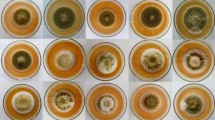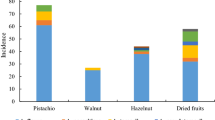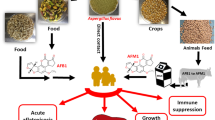Abstract
Important staple foods (peanuts, maize and rice) are susceptible to contamination by aflatoxin (AF)-producing fungi such as Aspergillus flavus. The objective of this study was to explore non-aflatoxin-producing (atoxigenic) A. flavus strains as biocontrol agents for the control of AFs. In the current study, a total of 724 A. flavus strains were isolated from different regions of China. Polyphasic approaches were utilized for species identification. Non-aflatoxin and non-cyclopiazonic acid (CPA)-producing strains were further screened for aflatoxin B1 (AFB1) biosynthesis pathway gene clusters using a PCR assay. Strains lacking an amplicon for the regulatory gene aflR were then analyzed for the presence of the other 28 biosynthetic genes. Only 229 (32%) of the A. flavus strains were found to be atoxigenic. Smaller (S) sclerotial phenotypes were dominant (51%) compared to large (L, 34%) and non-sclerotial (NS, 15%) phenotypes. Among the atoxigenic strains, 24 strains were PCR-negative for the fas-1 and aflJ genes. Sixteen (67%) atoxigenic A. flavus strains were PCRnegative for 10 or more of the biosynthetic genes. Altogether, 18 new PCR product patterns were observed, indicating great diversity in the AFB1 biosynthesis pathway. The current study demonstrates that many atoxigenic A. flavus strains can be isolated from different regions of China. In the future laboratory as well as field based studies are recommended to test these atoxigenic strains as biocontrol agents for aflatoxin contamination.
Similar content being viewed by others
References
Abbas, H.K., Zablotowicz, R.M., Bruns, H.A., and Abel, C.A. 2006. Biocontrol of aflatoxin in corn by inoculation with non-aflatoxigenic Aspergillus flavus isolates. Biocontrol. Sci. Technol. 16, 437–449.
Abbas, H.K., Zablotowicz, R.M., Horn, B.W., Phillips, N., Johnson, B.J., Jin, X., and Abel, C. 2011. Comparison of major biocontrol strains of non-aflatoxigenic Aspergillus flavus for the reduction of aflatoxins and cyclopiazonic acid in maize. Food Addit. Contam. Part A Chem. Anal. Control Expo. Risk Assess. 28, 198–208.
Abbas, H.K., Zablotowicz, R.M., Weaver, M.A., Horn, B.W., Xie, W. and Shier, W.T. 2004. Comparison of cultural and analytical methods for determination of aflatoxin production by Mississippi Delta Aspergillus isolates. Can. J. Microbiol. 50, 193–199.
Abdin, M.Z., Ahmad, M.M., and Javed, S. 2010. Advances in molecular detection of Aspergillus: An update. Arch. Microbiol. 192, 409–425.
Alaniz Zanon, M.S., Chiotta, M.L., Giaj-Merlera, G., Barros, G., and Chulze, S. 2013. Evaluation of potential biocontrol agent for aflatoxin in Argentinean peanuts. J. Food Microbiol. 162, 220–225.
Alaniz Zanon, M.S., Barros, G.G., and Chulze, S.N. 2016. Nonaflatoxigenic Aspergillus flavus as potential biocontrol agents to reduce aflatoxin contamination in peanuts harvested in Northern Argentina. Int. J. Food Microbiol. 231, 63–68.
Atehnkeng, J., Ojiambob, P.S., Cotty, P.J., and Bandyopadhyay, R. 2014. Field efficacy of a mixture of atoxigenic Aspergillus flavus Link: FR vegetative compatibility groups in preventing aflatoxin contamination in maize (Zea mays L.). Biol. Control 72, 62–70.
Atehnkeng, J., Ojiambo, P.S., Donner, M., Ikotun, T., Sikora, R.A., Cotty, P.J., and Bandyopadhyay, R. 2008. Distribution and toxigenicity of Aspergillus species isolated from maize kernels from three agro-ecological zones in Nigeria. Int. J. Food Microbiol. 122, 74–84.
Atehnkeng, J., Donner, M., Peter, S., Ikotun, B., Augusto, J., Cotty, J., and Bandyopadhyay, R. 2016. Environmental distribution and genetic diversity of vegetative compatibility groups determine biocontrol strategies to mitigate aflatoxin contamination of maize by Aspergillus flavus. Microb. Biotechnol. 9, 75–88.
Bock, C.H., Mackey, B., and Cotty, P.J. 2004. Population dynamics of Aspergillus flavus in the air of an intensively cultivated region of south-west Arizona. Plant Pathol. 53, 422–433.
Bruns, H.A. 2003. Controlling aflatoxin and fumonisin in maize by crop management. J. Toxicol. Toxin Rev. 22, 153–173.
Chang, P.K. 2004. Lack of interaction between AFLR and AFLJ contributes to nonaflatoxigenicity of Aspergillus sojae. J. Biotechnol. 107, 245–253.
Chang, P.K., Horn, B.W., and Dorner, J.W. 2005. Sequence breakpoints in the aflatoxin biosynthesis gene cluster and flanking regions in nonaflatoxigenic Aspergillus flavus isolates. Fungal Genet. Biol. 42, 914–923.
Chang, P.K., Horn, B.W., and Dorner, J.W. 2009. Clustered genes involved in cyclopiazonic acid production are next to the aflatoxin biosynthesis gene cluster in Aspergillus flavus. Fungal Genet. Biol. 46, 176–182.
Chang, P.K., Matsushima, K., Takahashi, T., Yu, J., Abe, K., Bhatnagar, D., Yuan, G.F., Koyama, Y., and Cleveland, T.E. 2007. Understanding nonaflatoxigenicity of Aspergillus sojae: A windfall of aflatoxin biosynthesis research. Appl. Microbiol. Biotechnol. 76, 977–984.
Chang, P.K., Skory, C.D., and Linz, J.E. 1992. Cloning of a gene associated with aflatoxin B1 biosynthesis in Aspergillus parasiticus. Curr. Genet. 21, 231–233.
Cotty, P.J. 1989. Virulence and cultural characteristics of two Aspergillus strains pathogenic to cotton. Postharvest Pathol. Mycotoxins 79, 808–814.
Cotty, P.J. 1994. Comparison of four media for the isolation of Aspergillus flavus group fungi. Mycopathologia 125, 157–162.
Criseo, G., Racco, C., and Romeo, O. 2008. High genetic variability in non-aflatoxigenic A. flavus strains by using Quadruplex PCRbased assay. Int. J. Food Microbiol. 125, 341–343.
Degola, F., Berni, E., and Restivo, F.M. 2011. Laboratory tests for assessing efficacy of atoxigenic Aspergillus flavus strains as biocontrol agents. Int. J. Food Microbiol. 146, 235–243.
Donner, M., Atehnkeng, J., Sikora, R.A., Bandyopadhyay, R., and Cotty, P.J. 2009. Distribution of Aspergillus section Flavi in soils of maize fields in three agroecological zones of Nigeria. Soil Biol. Biochem. 41, 37–44.
Donner, M., Atehnkeng, J., Sikora, R.A., Bandyopadhyay, R., and Cotty, P.J. 2010. Molecular characterization of atoxigenic strains for biological control of aflatoxins in Nigeria. Food Addit. Contam. Part A Chem. Anal. Control Expo. Risk Assess. 27, 576–590.
Dorner, J.W. 2004. Biological control of aflatoxin contamination of crops. Toxin. Rev. 23, 425–450.
Dorner, J.W. 2008. Management and prevention of mycotoxins in peanuts. Food Addit. Contam. Part A Chem. Anal. Control Expo. Risk Assess. 25, 203–208.
Dorner, J.W. and Cole, R.J. 2002. Effect of application of nontoxigenic strains of Aspergillus flavus and A. parasiticus on subsequent aflatoxin contamination of peanuts in storage. J. Stored Prod. Res. 38, 329–339.
Du, W., Obrian, G.R., and Payne, G. 2007. Function and regulation of aflJ in the accumulation of aflatoxin early pathway intermediate in Aspergillus flavus. Food Addit. Contam. 24, 1043–1050.
Fani, S.R., Moradi, M., Probst, C., Zamanizadeh, H.R., Mirabolfathy, M., Haidukowski, M., and Logrieco, A.F. 2014. A critical evaluation of cultural methods for the identification of atoxigenic Aspergillus flavus isolates for aflatoxin mitigation in pistachio orchards of Iran. Eur. J. Plant Pathol. 140, 631–642.
Flaherty, J.E. and Payne, G. 1997. Overexpression of aflR leads to upregulation of pathway gene transcription and increased aflatoxin production in Aspergillus flavus. Appl. Environ. Microbiol. 63, 3995–4000.
Frisvad, J.C., Thrane, U., Samson, R.A., and Pitt, J.I. 2006. Important mycotoxins and the fungi which produce them, pp. 3–31. In Advances in Food Mycology. Springer. USA.
Gao, J., Liu, Z., and Yu, J. 2007. Identification of Aspergillus section Flavi in maize in northeastern China. Mycopathologia 164, 91–95.
Gentles, A., Smith, E.E., Kubena, L.F., Duffus, E., Johnson, P., Thompson, J., Harvey, R.B., and Edrington, T.S. 1999. Toxicological evaluations of cyclopiazonic acid and ochratoxin A in broilers. Poult. Sci. 78, 1380–1384.
Gqaleni, N., Smith, J.E., Lacey, J., and Gettinby, G. 1997. Effects of temperature, water activity, and incubation time on production of aflatoxins and cyclopiazonic acid by an isolate of Aspergillus flavus in surface agar culture. Appl. Environ. Microbiol. 63, 1048–1053.
Hocking, A. and Pitt, J. 2012. Food, fungi and mycotoxins: an overview and update. Biomed. Sci. 56, 98–101.
Holzapfel, C.W. 1968. The isolation and structure of cyclopiazonic acid a toxic metabolite of Penicillium cyclopium Westling. Tetrahedron 24, 2101–2119.
Horn, B.W. and Dorner, J.W. 2011. Evaluation of different genotypes of nontoxigenic Aspergillus flavus for their ability to reduce aflatoxin contamination in peanuts. Biocontrol Sci. Technol. 21, 865–876.
Kenneth, C.E., Kobbeman, K., Montalbano, B.G., and Cotty, P.J. 2007. Aflatoxin-producing Aspergillus species from Thailand. Int. J. Food Microbiol. 114, 153–159.
Klich, M. 2007. Aspergillus flavus: The major producer of aflatoxin. Mol. Plant Pathol. 8, 713–722.
Kumar, V., Basu, M.S., and Rajendran, T.P. 2008. Mycotoxin research and mycoflora in some commercially important agricultural commodities. Crop. Prot. 27, 891–905.
Markus, B., Barbara, W., and Hoffmeister, D. 2010. Spotlights on advances in mycotoxin research. Appl. Microbiol. Biotechnol. 87, 1–7.
Nigam, S.N., Waliyar, F., Aruna, R., Reddy, S.V., Kumar, P.L., Craufurd, P.Q., Diallo, A.T., Ntare, B.R., and Upadhyaya, H.D. 2009. Breeding peanut for resistance to aflatoxin contamination at ICRISAT. Peanut Sci. 36, 42–49.
Passone, M.A., Resnik, S., and Etcheverry, M.G. 2007. Potential use of phenolic antioxidants on peanut to control growth and aflatoxin B1 accumulation by Aspergillus flavus and Aspergillus parasiticus. J. Sci. Food Agric. 87, 2121–2130.
Pitt, J.I., Manthong, C., Siriacha, P., Chotechaunmanirat, S., and Markwell, P.J. 2015. Studies on the biocontrol of aflatoxin in maize in Thailand. Biocontrol Sci. Technol. 25, 1070–1091.
Price, M.S., Yu, J., Nierman, W.C., Kim, H., Pritchard, B., Jacobus, C.A., Bhatnagar, D., Cleveland, T.E., and Payne, G.A. 2006. The aflatoxin pathway regulator AflR induces gene transcription inside and outside of the aflatoxin biosynthetic cluster. FEMS Microbiol. Lett. 255, 275–279.
Razzaghi-Abyaneh, M., Shams-Ghahfarokhi, M., Allameh, A., Kazeroon-Shiri, A., Ranjbar-Bahadori, S., Mirzahoseini, H., and Rezaee, M.B. 2006. A survey on distribution of Aspergillus section Flavi in corn field soils in Iran: Population patterns based on aflatoxins, cyclopiazonic acid and sclerotia production. Mycopathologia 161, 183–192.
Rodrigues, P., Santos, C., Venâncio, A., and Lima, N. 2011. Species identification of Aspergillus section Flavi isolates from Portuguese almonds using phenotypic, including MALDI-TOF ICMS, and molecular approaches. J. Appl. Microbiol. 111, 877–892.
Rodrigues, P., Venâncio, A., Kozakiewicz, Z., and Lima, N. 2009. A polyphasic approach to the identification of aflatoxigenic and non-aflatoxigenic strains of Aspergillus section Flavi isolated from Portuguese almonds. Int. J. Food Microbiol. 129, 187–193.
Scherm, B., Palomba, M., Serra, D., Marcello, A., and Migheli, Q. 2005. Detection of transcripts of the aflatoxin genes aflD, aflO, and aflP by reverse transcription-polymerase chain reaction allows differentiation of aflatoxin-producing and non-producing isolates of Aspergillus flavus and Aspergillus parasiticus. Int. J. Food Microbiol. 98, 201–210.
Tran-Dinh, N., Pitt, J.I., and Markwell, P.J. 2014. Selection of nontoxigenic strains of Aspergillus flavus for biocontrol of aflatoxins in maize in Thailand. Biocontrol Sci. Technol. 3157, 1–20.
Vaamonde, G., Patriarca, A., Ferna, V., Comerio, R., and Degrossi, C. 2003. Variability of aflatoxin and cyclopiazonic acid production by Aspergillus section Flavi from different substrates in Argentina. Int. J. Food Microbiol. 88, 79–84.
Varga, J., Frisvad, J.C., and Samson, R.A. 2011. Two new aflatoxin producing species, and an overview of Aspergillus section Flavi. Stud. Mycol. 69, 57–80.
Wei, D., Zhou, L., Selvaraj, J.N., Zhang, C., Xing, F., Zhao, Y., Wang, Y., and Liu, Y. 2014. Molecular characterization of atoxigenic Aspergillus flavus isolates collected in China. J. Microbiol. 52, 559–565.
Yin, Y., Lou, T., Yan, L., Michailides, T.J., and Ma, Z. 2009. Molecular characterization of toxigenic and atoxigenic Aspergillus flavus isolates, collected from peanut fields in China. J. Appl. Microbiol. 107, 1857–1865.
Yu, J., Fedorova, N.D., Montalbano, B.G., Bhatnagar, D., Cleveland, T.E., Bennett, J.W., and Nierman, W.C. 2011. Tight control of mycotoxin biosynthesis gene expression in Aspergillus flavus by temperature as revealed by RNA-Seq. FEMS Microbiol. Lett. 322, 145–149.
Zhang, C.S., Xing, F.G., Selvaraj, J.N., Yang, Q.L., Zhou, L., Zhao, Y.J., and Liu, Y. 2013. The effectiveness of ISSR profiling for studying genetic diversity of Aspergillus flavus from peanut-cropped soils in China. Biochem. Syst. Ecol. 50, 147–153.
Zhou, L., Wei, D.D., Selvaraj, J.N., Shang, B., Zhang, C.S., Xing, F.G., Zhao, Y.J., Wang, Y., and Liu, Y. 2015. A strain of Aspergillus flavus from China shows potential as a biocontrol agent for aflatoxin contamination. Biocontrol Sci. Technol. 25, 583–592.
Author information
Authors and Affiliations
Corresponding author
Rights and permissions
About this article
Cite this article
Mamo, F.T., Shang, B., Selvaraj, J.N. et al. Isolation and characterization of Aspergillus flavus strains in China. J Microbiol. 56, 119–127 (2018). https://doi.org/10.1007/s12275-018-7144-1
Received:
Revised:
Accepted:
Published:
Issue Date:
DOI: https://doi.org/10.1007/s12275-018-7144-1




